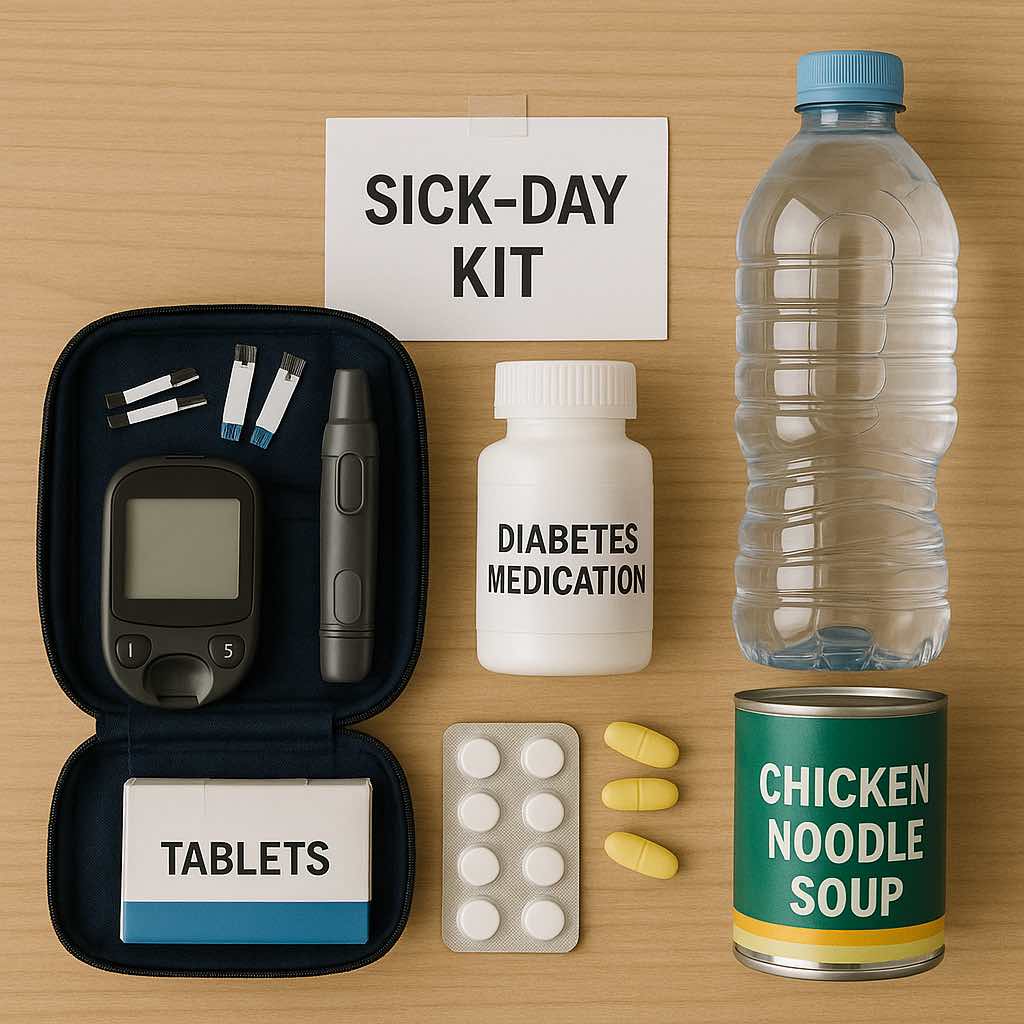When you’re living with diabetes, even a common cold or mild flu can make managing your blood sugar more challenging. Illness puts stress on your body, which can cause your blood sugar levels to rise unexpectedly. Having a well-thought-out sick-day plan is essential for maintaining control of your diabetes when you’re not feeling well.
How Illness Affects Blood Sugar
Understanding why your blood sugar changes during illness helps you respond appropriately:
Stress Hormones: When you’re sick, your body releases stress hormones like cortisol and adrenaline, which can cause your liver to release more glucose into your bloodstream.
Altered Eating Patterns: You might eat differently when you’re ill‚Äîeither less than usual due to nausea or more comfort foods that are higher in carbohydrates.
Reduced Activity: Being less active while recovering can affect how your body uses insulin.
Dehydration: Fever, vomiting, or diarrhea can lead to dehydration, which concentrates glucose in your bloodstream.
Medications: Some over-the-counter cold and flu remedies contain sugar or ingredients that affect blood sugar levels.
These factors can make your diabetes more difficult to manage during illness, but with proper planning, you can maintain better control.
When to Call Your Doctor
Not every sniffle requires medical attention, but certain situations warrant contacting your healthcare provider promptly:
Call immediately if you experience:
- Vomiting or diarrhea that lasts more than 6 hours
- Blood sugar above 240 mg/dL that doesn’t respond to medication
- Moderate to large ketones in your urine (for people with type 1 diabetes)
- Difficulty breathing
- Confusion or unusual drowsiness
- Severe pain
- Persistent fever
Also call if you’re unsure about:
- How to adjust your medication during illness
- Which over-the-counter medications are safe to take
- How to manage persistent high blood sugar
Remember, it’s always better to call with questions than to wait until a situation becomes serious.
Medication Adjustments During Illness
A common misconception is that you should stop taking your diabetes medications when you’re sick, especially if you’re eating less. In reality:
Continue taking your diabetes medications: Even if you’re eating less, your blood sugar may still be elevated due to stress hormones.
Insulin users may need adjustments: People who use insulin often need more insulin during illness, not less. Your healthcare provider can give you specific guidelines for adjusting insulin doses based on your blood sugar readings.
Certain medications may need temporary changes: Some medications, like SGLT2 inhibitors, may need to be temporarily stopped during severe illness, especially with vomiting, diarrhea, or reduced food intake. Always consult your healthcare provider before stopping any prescribed medication.
Staying Hydrated and Nourished
Proper hydration and nutrition are crucial when you’re sick:
Hydration goals:
- Drink at least 8 ounces of fluid every hour while awake
- Choose sugar-free options like water, sugar-free sports drinks, or broth when blood sugar is high
- Include some liquids with carbohydrates if blood sugar is normal or low
Nutrition strategies:
- Aim to consume your regular amount of carbohydrates, spread throughout the day
- If you can’t eat your normal meals, substitute with easy-to-digest carbohydrates like:
- Crackers or toast
- Applesauce or fruit juice
- Regular gelatin or popsicles
- Soup
- Yogurt
- Regular soft drinks (if blood sugar is low)
If you can’t keep food down:
- Focus on small sips of carbohydrate-containing fluids
- Try eating very small amounts frequently
- Monitor blood sugar closely
Creating Your Sick-Day Kit
Prepare a sick-day kit in advance so you have everything you need when illness strikes:
Monitoring supplies:
- Extra blood glucose test strips
- Ketone testing strips (especially important for type 1 diabetes)
- Thermometer
- Extra batteries for your glucose meter
Medications:
- Your regular diabetes medications
- Glucose tablets or gel for low blood sugar
- Sugar-free cough drops or cough syrup
- Sugar-free throat lozenges
- Fever reducer/pain reliever (acetaminophen or ibuprofen)
Food and drink:
- Easy-to-prepare foods with consistent carbohydrate content
- Regular and diet clear liquids
- Instant soups or broths
- Crackers or plain bread
Contact information:
- Your healthcare provider’s phone number
- Your pharmacy’s phone number
- Emergency contact information
Monitoring Guidelines During Illness
More frequent monitoring is essential when you’re sick:
Blood glucose:
- Check at least every 2-4 hours, including during the night
- Record all readings
Ketones (especially for type 1 diabetes):
- Check when blood glucose is above 240 mg/dL
- Check if you’re experiencing nausea, vomiting, or abdominal pain
- Record results
Temperature:
- Monitor at least twice daily
- Record readings
Medication timing and doses:
- Keep track of all medications taken
- Note any adjustments made
Food and fluid intake:
- Track what you’re able to consume
- Note any episodes of vomiting or diarrhea
Returning to Normal
As you recover:
Gradually resume your normal eating pattern as your appetite returns.
Continue monitoring frequently until your blood sugar stabilizes in your target range.
Return to your usual medication schedule as directed by your healthcare provider.
Rest and recover fully before returning to your normal activity level.
Be Prepared Before Illness Strikes
Don’t wait until you’re sick to create your plan. Take action now by:
- Discussing sick-day guidelines with your healthcare provider
- Assembling your sick-day kit
- Writing down your specific sick-day plan, including when to call for help
- Sharing your plan with family members or caregivers
Having a well-prepared sick-day plan gives you confidence to manage your diabetes effectively, even when you’re not feeling your best.

